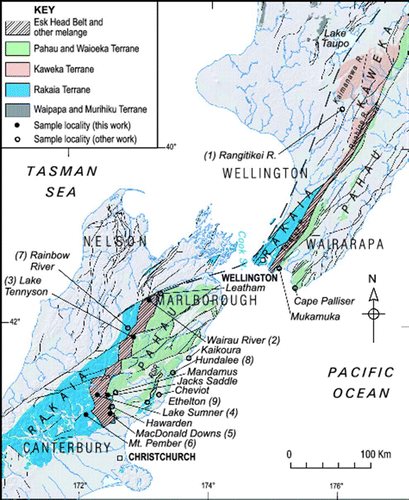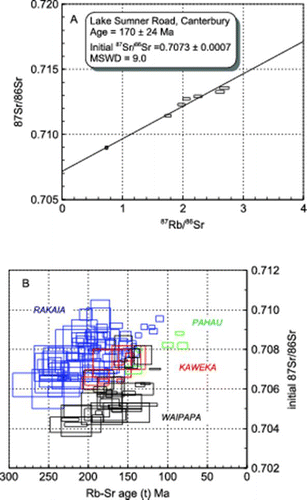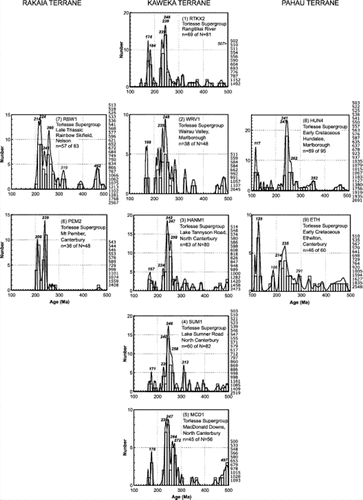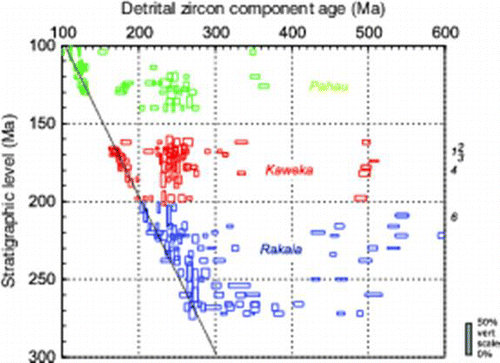Figures & data
Figure 1 Basement rocks of the northern South Island and southern North Island, New Zealand, showing the main study area with sample localities and numbers of this and previously published geochronological studies (locality numbers in italics in brackets) and other places mentioned in text. Rakaia, Kaweka and Pahau Terranes of the Torlesse Composite Terrane are shown separately. Solid dashed line is the Torlesse/Waipapa Terrane boundary. Esk Head Belt and other melange belts (RSR Random Spur Melange, South Island; Rimutaka Melange, North Island) are indicated by diagonal ruling.

Table 1 Kaweka Terrane South Island study: details of Torlesse sandstone samples.
Figure 2 Isochron diagrams. A, Rb–Sr whole-rock isochron diagram for Torlesse Composite Terrane metasediments at locality (4), Lake Sumner Rd, North Canterbury (data in ). B, Rb–Sr isochron age (t) and initial 87Sr/86Sr ratio (i) whole-rock isochron data for Torlesse and Waipapa metasediments throughout New Zealand (Graham & Mortimer Citation1992; Adams & Graham Citation1996, Citation1997; Adams et al. Citation1999, Citation2009a; Adams & Maas Citation2004a, Citationb; this work). Waipapa Terrane: black; Torlesse Composite Terrane subunits Rakaia Terrane: blue; Kaweka Terrane: red; Pahau Terrane: green; Kaweka Terrane locality (4): bold. Decay constants used are from Steiger & Jaeger 1977.

Table 2 Rb–Sr whole-rock isochron analytical and age data for Torlesse metasediments at locality (4) in North Canterbury.
Figure 3 Combined cumulative probability/histogram diagrams of detrital zircon age data from Torlesse sandstones in the Kaweka Terrane (middle column) compared with those from neighbouring Rakaia Terrane (left column) to the west and Pahau Terrane to the east (right column). Dataset for locality (1) is a representative Kaweka sandstone from the upper Rangitikei River area, central North Island (Adams et al. Citation2009a). Below this, datasets for localities (2)–(5) are from suggested equivalent rocks in Marlborough and North Canterbury, South Island (this work). Rakaia Terrane datasets are from northern South Island: dataset at locality (6) is from Rainbow River, Nelson (Pickard et al. Citation2000) and at locality (7) from Mt Pember, Canterbury (this work). Pahau terrane datasets for locality (8) are from Hundalee, North Canterbury (Pickard et al. Citation2000) and for locality (9) from Ethelton (Wandres et al. Citation2004a). Significant age components (expressed in millions of years) are shown in bold italics; other age components are shown in normal italics (from Appendix 1). Ages >500 Ma are stacked at the right-hand side. Ages < 1000 Ma are 238U/206Pb data, ages > 1000 Ma are 207Pb/206Pb data.

Figure 4 Detrital zircon 238U/206Pb age components derived from cumulative probability diagrams ( and Appendix 1) for metasediments of the Torlesse Composite Terrane, stacked vertically from top to bottom in ascending order of maximum stratigraphic age. Where the stratigraphic age is uncertain, a maximum age estimate is taken from the youngest zircon ages and/or minimum metamorphic age data (where available). Each data box represents a significant zircon age component of n ≥ 4 analyses and ≥ 4% of total dataset (usually N = 50–100), whose position and width on the horizontal axis represent the component age and error and whose height on the vertical axis shows the proportion of that component as a percentage of the total dataset (for comparison see scale bar at right, representing 25%). Data boxes from the present study are bold; those from previously published work are light. The dot-dash diagonal line represents a stratigraphic age limit, the minimum value for detrital zircons. Locality numbers (in italics) are at right margin.
